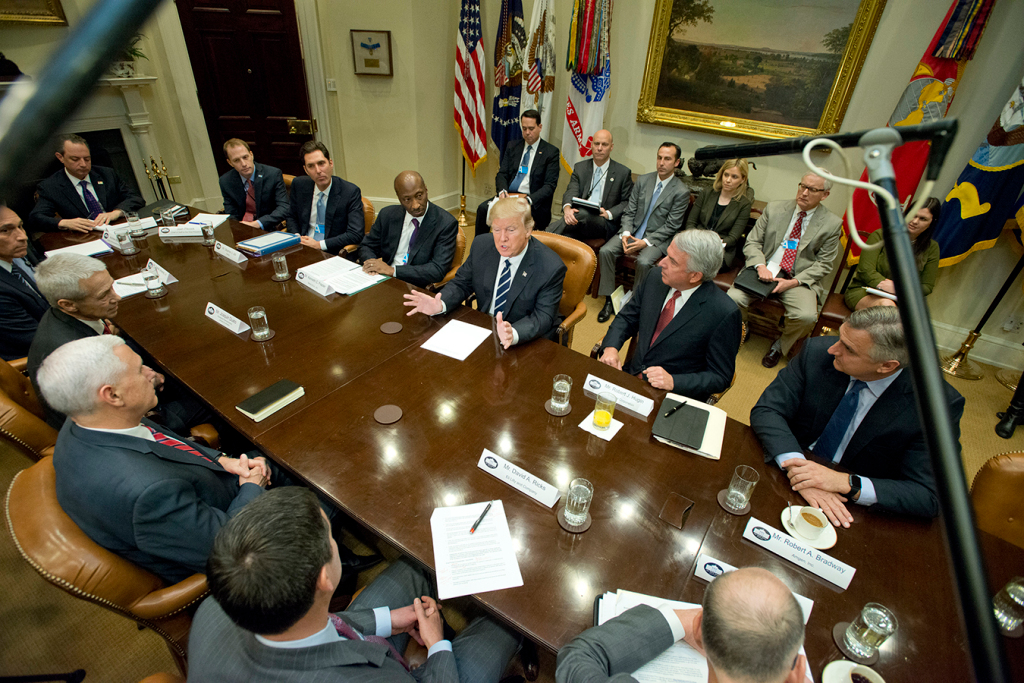Analysis: The Trump Health Care Policies That Deserve to Stick Around

President Joe Biden’s goal of providing health care for more Americans advanced this week with his signing of an economic stimulus package that includes subsidies for health insurance premiums and new incentives for states to expand Medicaid, as well as the potential confirmation of Xavier Becerra as secretary of Health and Human Services.
This story also ran on The New York Times. It can be republished for free.
But as the current administration works to reverse the actions of its predecessor, it should recognize that former President Donald Trump introduced policies on medical care and drug price transparency that are worth preserving. Those measures could help struggling patient-consumers while the new administration pushes for the far more ambitious reforms Biden campaigned on, which include a public health insurance option and a system that would allow Medicare to negotiate drug prices.
To be clear, the Trump administration, generally, put the health care of many Americans in jeopardy: It spent four years trying to overturn the Affordable Care Act, despite that law’s undeniable successes, and when repeal proved impossible, kneecapped the program in countless ways. As a result of those policies, more than 2 million people lost health insurance during Trump’s first three years. And that’s before millions more people lost their jobs and accompanying insurance during the early days of the covid-19 pandemic.
But the Trump administration did attempt to rein in some of the most egregious pricing in the health care industry. For example, it required most hospitals to post lists of their standard prices for supplies, drugs, tests and procedures. Providers had long resisted calls for such pricing transparency, arguing that this was a burden, and that since insurers negotiated and paid far lower rates anyway, those list prices didn’t matter.
Of course, prices do matter to the patients who are uninsured or end up at an out-of-network hospital when illness strikes and are charged full freight, or nearly so. Some patients, facing bills of hundreds of thousands of dollars, have been sued by hospitals or forced into bankruptcy or foreclosure.
In 2019, the Trump administration proposed a rule that hospitals disclose the discounted rates that they agree to accept from insurers for common medical services, as well as prices for patients who pay in cash. To be clear, this type of transparency doesn’t directly lower bills, but the information can help patients shop around for medical care.
These master price lists span hundreds of pages and are hard to decipher. Nonetheless, they give consumers a basis to fight back against outrageous charges in a system where a knee replacement can cost $15,000 or $75,000, even at the same hospital. And the requirement might just motivate some providers to lower their prices, if only to compete with neighboring hospitals.
Last summer, hospitals said it was too hard to comply with the new rule while they were dealing with the pandemic. They still managed to continue the appeal of their lawsuit against the measure, which failed in December. The rule took effect, but the penalty for not complying is just $300 a day — a pittance for hospitals — and there is no meaningful mechanism for active enforcement. The hospitals have asked the Biden administration to revise the requirement.
Trump also used his bully pulpit to take on drug prices, remarking at his first news conference as president-elect that pharmaceutical manufacturers were “getting away with murder.” His administration ordered drugmakers to list prices in advertisements for medications that cost more than $35 per month. (Some of the most commonly advertised drugs cost thousands of dollars.) Just before the order took effect, a court blocked it.
Then, last summer, Trump issued a bunch of executive orders aimed at forcing drug price reductions. In September his health secretary, Alex Azar, certified that importing prescription medicine from Canada “poses no additional risk to the public’s health and safety” and would result in “a significant reduction in the cost.” This statement, which previous health secretaries had declined to make, formally opened the door to importing medication. Millions of Americans, meanwhile, now illegally purchase prescription drugs from abroad because they cannot afford to buy them at home.
In Congress, bills allowing prescription drug importation have for years gained bipartisan support, but without the go-ahead from the Department of Health and Human Services, they were nonstarters. Now a number of states are moving ahead with efforts to import drugs from Canada.
Biden said he supported the legalization of importing drugs during his presidential campaign. Becerra, Azar’s potential successor, voted for an importation bill in 2003 when he was a member of Congress.
But the drug lobby will no doubt prove a big obstacle: The Pharmaceutical Research and Manufacturers of America, an industry trade group, filed suit in federal court in November to stop the drug-purchasing initiatives. The industry has long argued that importation from even Canada would risk American lives.
Finally, shortly before the election, Trump issued an executive order paving the way for a “most favored nation” system that would ensure that the prices for certain drugs purchased by Medicare did not exceed the lowest price available in other developed countries. The industry responded with furious pushback, and a court quickly ruled against the measure.
Some of these initiatives, such as posting hospital prices, have already taken effect. But executive orders have limited power; some are stuck in court or require further governmental action to move forward. The Biden administration will have to decide which, if any, to pursue.
Biden’s proposals to get better, more affordable health care to every American are far more substantial — and disruptive to the health industry — than any of Trump’s efforts. But Biden may find it difficult to get support for his plans in a Congress that is narrowly controlled by Democrats. The Democratic Party has historically been friendly to the health care industry: According to the Center for Responsive Politics, 71% of the money spent by the pharmaceutical industry in the 2020 elections went to Democratic candidates. Biden raised twice as much money from hospitals and nursing homes during the 2020 presidential campaign as Trump did. The health care industry is already aggressively advertising and lobbying against any sort of public option.
The Trump administration’s attempted market-based interventions shined some light on dark corners of the health market and opened the door to some workarounds. They are not meaningful substitutes for larger and much-needed health reform. But as Americans await the type of more fundamental changes the Democrats have promised, they need every bit of help they can get.
KHN (Kaiser Health News) is a national newsroom that produces in-depth journalism about health issues. Together with Policy Analysis and Polling, KHN is one of the three major operating programs at KFF (Kaiser Family Foundation). KFF is an endowed nonprofit organization providing information on health issues to the nation.
USE OUR CONTENT
This story can be republished for free (details).


